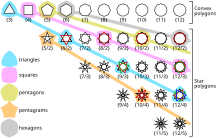| This article needs additional citations for verification. Please help improve this article by adding citations to reliable sources. Unsourced material may be challenged and removed. Find sources: "Complex polygon" – news · newspapers · books · scholar · JSTOR (October 2009) (Learn how and when to remove this message) |
| This article may lack focus or may be about more than one topic. Please help improve this article, possibly by splitting the article and/or by introducing a disambiguation page, or discuss this issue on the talk page. (May 2024) |
The term complex polygon can mean two different things:
- In geometry, a polygon in the unitary plane, which has two complex dimensions.
- In computer graphics, a polygon whose boundary is not simple.
Geometry
Further information: Complex polytope § Regular complex polygonsIn geometry, a complex polygon is a polygon in the complex Hilbert plane, which has two complex dimensions.
A complex number may be represented in the form , where and are real numbers, and is the square root of . Multiples of such as are called imaginary numbers. A complex number lies in a complex plane having one real and one imaginary dimension, which may be represented as an Argand diagram. So a single complex dimension comprises two spatial dimensions, but of different kinds - one real and the other imaginary.
The unitary plane comprises two such complex planes, which are orthogonal to each other. Thus it has two real dimensions and two imaginary dimensions.
A complex polygon is a (complex) two-dimensional (i.e. four spatial dimensions) analogue of a real polygon. As such it is an example of the more general complex polytope in any number of complex dimensions.
In a real plane, a visible figure can be constructed as the real conjugate of some complex polygon.
Computer graphics
See also: orbit (dynamics) and winding number

In computer graphics, a complex polygon is a polygon which has a boundary comprising discrete circuits, such as a polygon with a hole in it.
Self-intersecting polygons are also sometimes included among the complex polygons. Vertices are only counted at the ends of edges, not where edges intersect in space.
A formula relating an integral over a bounded region to a closed line integral may still apply when the "inside-out" parts of the region are counted negatively.
Moving around the polygon, the total amount one "turns" at the vertices can be any integer times 360°, e.g. 720° for a pentagram and 0° for an angular "eight".
See also
References
Citations
- Coxeter, 1974.
- Rae Earnshaw, Brian Wyvill (Ed); New Advances in Computer Graphics: Proceedings of CG International ’89, Springer, 2012, page 654.
- Paul Bourke; Polygons and meshes:Surface (polygonal) Simplification 1997. (retrieved May 2016)
Bibliography
- Coxeter, H. S. M., Regular Complex Polytopes, Cambridge University Press, 1974.
External links
This geometry-related article is a stub. You can help Misplaced Pages by expanding it. |
 , where
, where  and
and  are
are  is the square root of
is the square root of  . Multiples of
. Multiples of  are called
are called